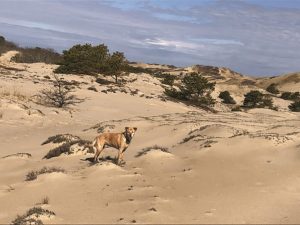The British inventor Lord Kelvin famously said that if you can’t measure something, “your knowledge is of a meagre and unsatisfactory kind.” I heartily disagree.
The most important things in life — beauty, peace, faith, friendship, love — cannot be quantified. At the same time, these things are difficult to discuss. Love is especially hard to discuss without getting, well, cheesy. I love my wife and the family we have created, and, on a different level, I love my crazy town and its community, and beyond that my country (with conditions), and so on.
But to discuss the love of animals, specifically pets, is to court cheesiness. I dare to risk it simply because of the overwhelming interest in and love for pets on the Outer Cape. There is much coverage of goats and chickens in these pages. My neighbors have a couple of horses. I have a friend who dotes on an 80-pound tortoise. Provincetown was voted one of the most dog-friendly towns in the country; cats, although less visible, also abound.
What is it about the unspoken bond between humans and their pets that has such primacy in our lives? Where does it come from and why does it exist? We, too, are animals and come from the natural world not that many generations ago. Some of us, and some part of all of us, seek nature in its many manifestations. Wild animals awe us, but it can be difficult to keep their company. Our pets represent a way to connect. (So do our house plants and gardens, for that matter). Over centuries dogs and cats, especially, have been domesticated. They have evolved to meet us halfway (though cats have to be taken a bit more on their own terms). We can and do share our lives with them.
If we approach this sharing with open minds, there is much to learn from our pets. For one thing, we must suspend our goal-oriented perspectives and spend more time in the moment: just go for a walk, for instance.
 When my dog, Dory, and I stroll on the beach we are a team, or, more strictly speaking, a duo: we are together and at the same time apart. She is usually (and extra-legally) off leash. She follows her nose where it takes her, tracking the scents that have been laid down since our last walk. She long ago accepted my profound limitations in the realm of smells. I talk to her as we go along but long ago accepted her deficiency as a conversationalist, and so we speak in the simplest terms. I try to imagine what she is taking in; perhaps she is doing me the same favor. We are both satisfied.
When my dog, Dory, and I stroll on the beach we are a team, or, more strictly speaking, a duo: we are together and at the same time apart. She is usually (and extra-legally) off leash. She follows her nose where it takes her, tracking the scents that have been laid down since our last walk. She long ago accepted my profound limitations in the realm of smells. I talk to her as we go along but long ago accepted her deficiency as a conversationalist, and so we speak in the simplest terms. I try to imagine what she is taking in; perhaps she is doing me the same favor. We are both satisfied.
On the beach, Dory is in her own world, yet not entirely. She is always aware of my presence and almost always in range of my voice. My slightest gesture is apparent to her. When I stop, so does she; if I turn, so does she. I am continually drawn to my own thoughts and concerns but never without a sense of her. If her mood changes, I take note. Where does the dog stop and the human begin? There is mutual consideration — dare I say devotion — in our bond.
And so, we come back to love. I say simply and unapologetically that I love my dog. If I suggest that she loves me back, I might be accused of anthropomorphism: ascribing to animals thoughts or feelings that only humans can have. The more mechanistic school of animal behavior would state that a dog is a pack animal and has certain prescribed behaviors that allow it to exist but are not akin to the human notion of love. This school would posit that I am projecting my inclinations onto an animal that does not actually have them.
That point of view may be valid, but I have no interest in it. We are standing on a storm-tossed beach on a steel-gray day. I tell her she is a good girl. She wags her tail. I smile. That’s all there is to it.



